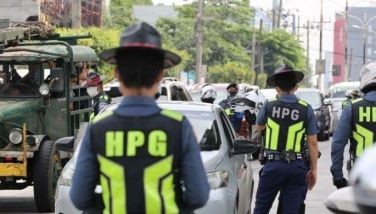16 M failed to vote for party-list, missed names on back of ballot
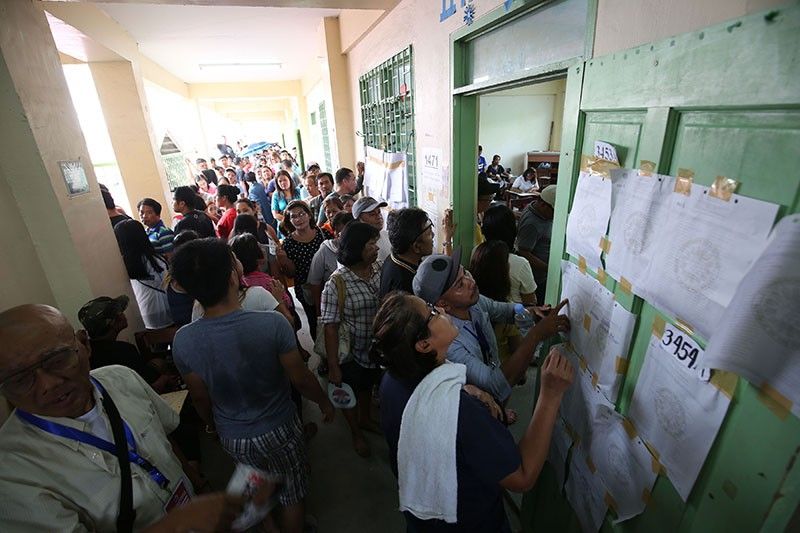
May 2019 elections: Fraud-free? Fault-free?
Failed to pick a party-list group in the last elections?
You weren’t the only one. Official figures indicate that those who voted in the May 13, 2019 polls but didn’t select or weren’t able to select any party-list organization to be part of the 18th Congress could reach nearly 40 percent of the total. That’s quite a leap from the undervoting rate for the party-list election in 2016, which is estimated to be around 20 percent.
Data from the Commission on Elections even reveal four provinces as having undervoting rates above 50 percent in the recent party-list race: Zamboanga del Sur, Siquijor, Zamboanga del Norte, and Negros Oriental. Thirty-nine provinces recorded undervoting rates between 40 and 49 percent, while most of the rest reached 30 percent.
Six provinces also had their party-list undervoting rates going up by more than 25 percentage points from 2016 to 2019: Camarines Norte, Guimaras, Mountain Province, Nueva Vizcaya, Sorsogon, and Zamboanga del Sur. Mountain Province recorded the highest surge in party-list undervoting, shooting up from 20.52 percent in 2016 to 49.60 percent in 2019, or a difference of 29.08 percentage points.
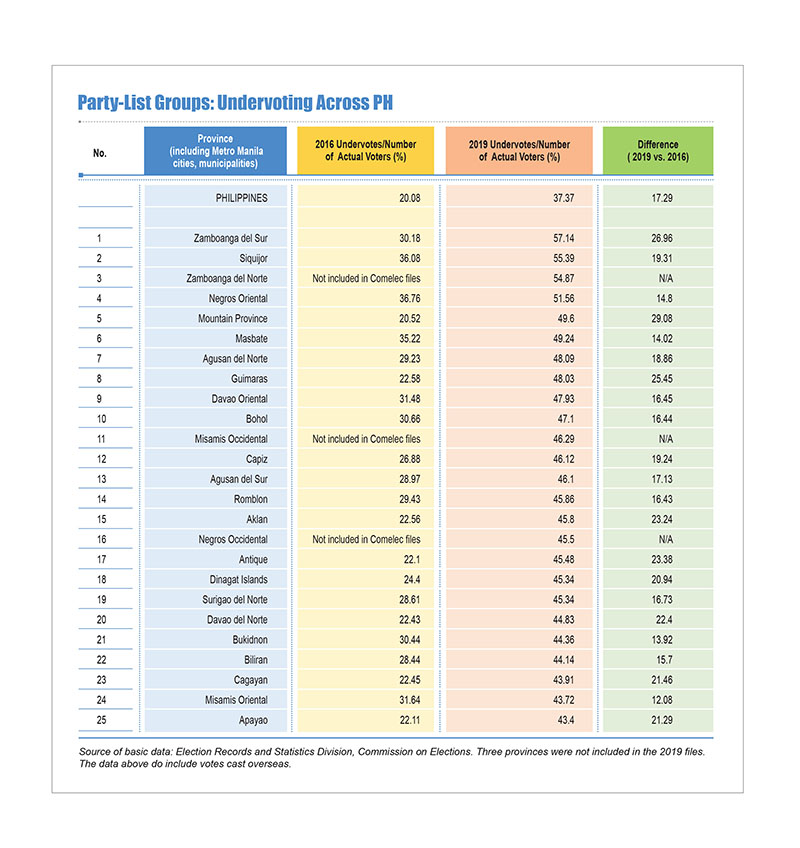
Comelec’s Election Records and Statistics Division (ERSD) data show that in the 2016 polls, only one province had a party-list undervoting rate that went beyond 40 percent: Batanes, with 42.64 percent. Ten had rates between 30 and 37 percent. (Batanes figures went missing in Comelec ERSD 2019 elections file given to PCIJ. The Election Office in Batanes apparently hasn’t submitted its data to Comelec as of this writing.)
An "undervote" refers to situation in which a voter selects less than the maximum number of seats allowed for a position. For a single-slot position such as the party-list poll, an undervote for means that no vote was cast or no oval was shaded in the ballot for that post. (An overvote, meanwhile, happens when a voter chooses more candidates than the maximum number allowed.)
Undervoting happens every election across all positions; a voter might choose to not fill up all the maximum slots allowed for a multi-slot position or just decide that he or she will not vote anyone for a particular post. But in the May 2019 elections, a change in the ballot layout is being eyed by some as one of the main reasons why the party-list polls suffered what is looking like major undervoting.
Didn’t notice list
“Hindi ko naisip na wala pala (I didn’t notice that the party-list section wasn’t there),” says Cecille Marinda, referring to the front of the ballot. “Hinanap ko sana (I should have looked for it).”
Marinda, from Cavite City, had gone out to vote with her husband and their two grown children. She realized she had missed choosing among the party-list groups in the running only the following morning, when she and her colleagues were comparing notes on how each of them had voted. Marinda says that it turned out her husband didn’t get to vote for any party-list organization as well.
Since 1998, when Filipinos began voting for party-list groups to participate in Congress, the Comelec had put the partylist-organization candidates on the front of the ballot, almost always after the congressional district candidates. The back of the ballot was always reserved for the local races.
That made for a very long ballot, of course. For the 2019 polls, however, Comelec decided to put the party-list groups on the back of the ballot, and the rest of the other positions on its front, apparently to save on paper.
Some party-list groups and observers say that the change in the ballot’s layout could have caused many voters to overlook the party-list race. Several party-list organizations that had seats in the 17th Congress but were shut out this time around even blame the change for their loss, while there are those that won in the May polls that say that it prevented them from having more seats in the House.
Former AGRI Party-List Rep. Orestes T. Salon has been quoted by BusinessWorld as saying that his group had more than 800,000 votes in the 2016 elections, but had only 133,000 votes in 2019. A report by CNN Philippines meanwhile had Alfredo A. Garbin Jr. of Ako-Bicol grousing about the placement of the list of party-list organizations on the ballot.
“Nilagay niyo ho sa likod eh (You placed it at the back),” CNN Philippines quoted Garbin as saying. “And the numbers (are) very telling. If I’m not mistaken, 27 million total votes cast in the party-list election out of 63 million registered voters. Sobrang bagsak ang boto sa (There is a huge drop in votes for) party-list as compared to 2016 election."
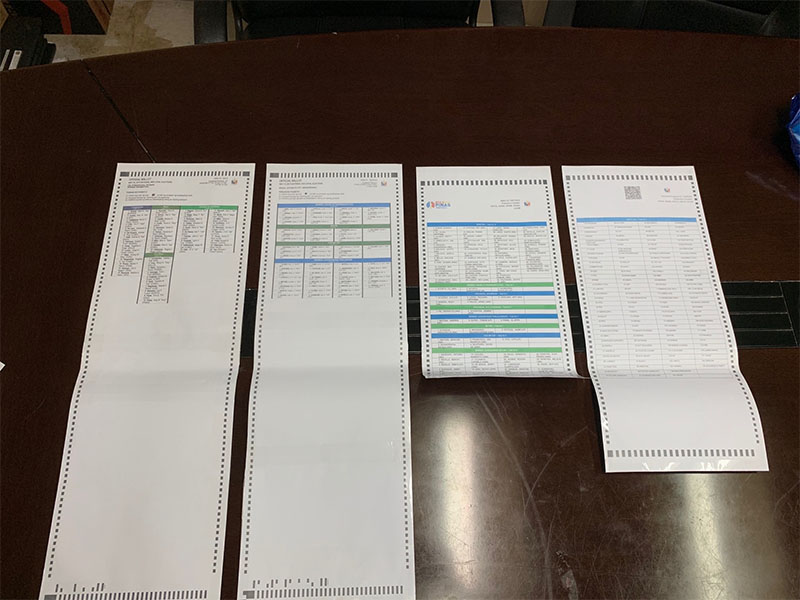
AGRI no longer has any slots in the House while Ako-Bicol now has just two, instead of its previous three.
Incomplete stats
The party-list system, designed to afford and guarantee the marginalized sectors of having representation in Congress, allows 20 percent of the House of Representatives to be made up of representatives of these groups. The number of seats allocated per party-list group is determined by the percentage of votes it gets against the total votes cast for all the groups. Under the law, a winning party-list group can secure a maximum of three seats.
A total of 134 party-list groups ran in the 2019 polls. Comelec proclaimed 51 as winners, with the top two party-list groups getting three seats, while the next six other organizations got two seats each and the rest of the 43 groups one seat each. The current House of Representatives thus has 61 seats occupied by only party-list groups.
In 2016, only 46 groups were proclaimed winners in the party-list elections, taking a total of 59 seats in the 17th Congress.
Voting statistics from Comelec’s ERSD are unfortunately incomplete, however. For instance, the files it gave PCIJ for the 2016 elections excluded nine provinces and five Metro Manila cities. Three provinces meanwhile were not included in the 2019 files. Interestingly, there were no common omissions between the data covering the two elections, except for the overseas votes, which were absent in both files. (Comelec ERSD does not have undervoting data from 2013 and 2010.)
The undervoting rate is computed by taking the percentage of the number of undervotes from the number of total valid votes or number of actual voters.
Based on the available figures, out of the 34.6 million Filipinos Comelec files show as having voted in the 2016 polls, 6.9 million or about 20 percent did not choose any party-list organization for Congress.
In the May 2019 elections, 15.9 million out of 42.7 million voters – or 37.7 percent – did not select a party-list group. The undervoting rate for the 2016 elections, using available figures, would then be 20.08 percent, and for 2019, 37.37 percent.
PCIJ tried to make the data more comparable by taking out the all the areas Comelec does not have figures on, or a total of 15 for each election year. The results were undervoting rates of 20.37 percent for the 2016 polls and 37.74 percent for the 2019 elections, or an increase of 17.37 percentage points.
Comelec also computes the ballot fill-up rate by taking the percentage of the votes obtained by all candidates from the total valid votes. The party-list position had the lowest fill-up rate among all positions in the 2019 elections at 58.14 percent on average. In 2016, the average fill-up rate for party-list was 70.56 percent.
The senatorial race had a rather low fill-up rate in 2019 as well, at 62.11 percent on average. But this figure is slightly higher than the rate in 2016, which was 56.93 percent.
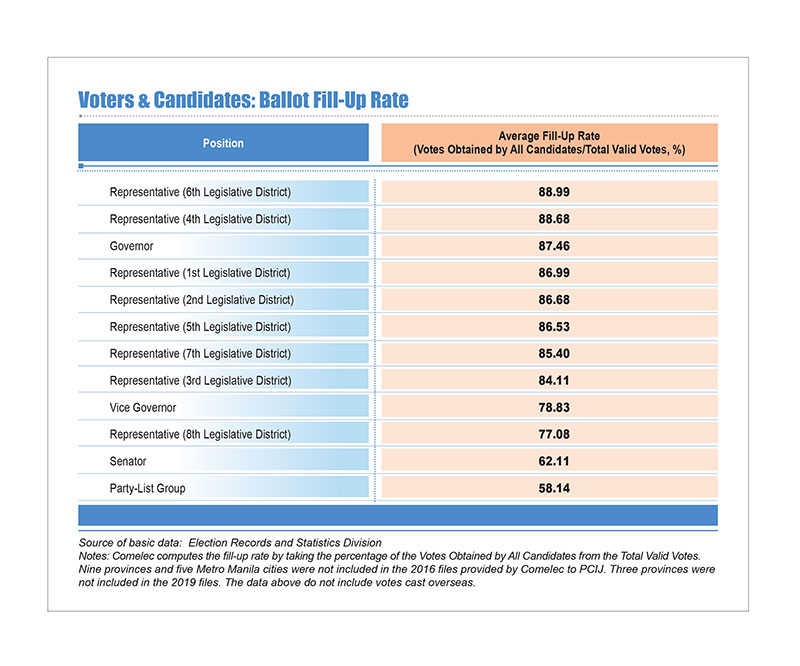
‘A few, not a lot, of cases’
Comelec Spokesperson James Jimenez allows that the change in the ballot layout might account for a few instances of undervotes in the party-list race. But he says that it would be a stretch to claim that having the party-list organizations on the back of the ballot is the main reason why many people didn’t vote for any of these groups.
“At most we would say that, yes, it probably accounted for a few cases, but certainly not a lot,” Jimenez says.
He says that the Board of Election Inspectors (BEIs) were trained to tell the voters to check both sides, while the Parish Pastoral Council for Responsible Voting (PPCRV) volunteers were also telling voters about the back of the ballot.
The change in the layout, Jimenez says, was an attempt to optimize the ballot. Showing PCIJ ballots from the last four elections, he points out that the party-list groups tend to take up a lot of space when placed on the front of the ballot, while the back has a lot of empty space because the list of local candidates (for governor, vice governor, mayor, vice mayor, and councilors) is not always as long as that of the party-list groups.
Jimenez says that a lot of people are trying to insinuate or circle around the possibility that the layout was changed to compromise the party-list system. He argues that it may well be that voters were not really intent on making any party-list selection. Asks Jimenez: “Would you have voted for a party-list group to begin with? Because to my mind, it seems like if you're setting out to vote for a party-list, that's at least among top three things you would look for.”
The Comelec official says that he wonders why voters did not check the back of the ballot despite having heard all the party-list campaigns. He notes, “Are we benighted as a people that we cannot even flip the paper over?”
He says that there are many other factors, including how the public feels about the party-list groups, that could have affected the voting for these groups. For instance, he says, “how have they presented the party-list (system) to the voting public? Have they accounted for the entrance of new party-list players that are very popular in the extreme?”
Too, for some time now, the party-list system has been criticized for not being truly representative of the marginalized. It has even been described as “bastardized,” with the system hijacked by some political dynasties to expand and extend their rule in Congress.
Then again, some party-list groups have also been noted to have helped pass landmark legislations such as the Reproductive Health Law, the Sangguniang Kabataan Reform Law, and the Philippine Competition Act. That may be why the likes of Cecille Marinda still would have gladly shaded an oval in the party-list section in the last elections.
No notice to voters
The problem, says Marinda, was that the officers at her and her husband’s precinct did not say anything about the back of the ballot. She says that she didn’t look because she thought the positions and selections were all on the front. Usually, says Marinda, the selections for councilors mark the end of the ballot.
Her children at least were able to make party-list selections, she says, because the election officers in their precinct reminded them to look at the back of the ballot. (Cavite posted an undervoting rate of 32.58 percent in the May 2019 elections, up by 19.11 percent points from its 2016 figure of 13.47 percent.)
PPCRV Board Member Arwin Serrano, for his part, says that he conducted voter-education drives, but he himself isn’t satisfied with what he had done after seeing the results of the elections. He says that he feels that he could have done more, partly because his seminars were held in universities and in areas where he thinks people are already aware of what to do during elections.
Eric Alvia, secretary general of the National Citizens’ Movement for Free Elections (NAMFREL), meantime comments that no decision is ever too small when it comes to elections. The decision to change ballot layout without making sure that voters are aware of the change led to partial disenfranchisement, he says.
Alvia remarks, “Nakatipid nga tayo sa papel pero ito naman, maraming di nakakita na botante na ‘Ah meron pala sa likod’ (We did save on paper, but many voters didn’t realize that there was still content on the back of the ballot).”
Alvia says that it boils down to Comelec’s project management office. “You don’t just change things on a whim,” he says. “It’s like, okay, let’s make changes, but without cognizance that there are things that will be affected by that change.”
Because it was the first time that the party-list section was placed on the back of the ballot, he says, Comelec should have ensured that voters were “educated” of the change.
His colleague, NAMFREL National Council Member Lito Averia, suggests that it might have been a good idea to add a note at the end of the front page that said, “Please see back.”
Averia says that a friend of his didn’t see the party-list section until he was already inserting his ballot in the machine. Recounts Averia: “Gusto niya hatakin (He wanted to pull the ballot out of the machine).” – Philippine Center for Investigative Journalism, August 2019
- Latest
- Trending























